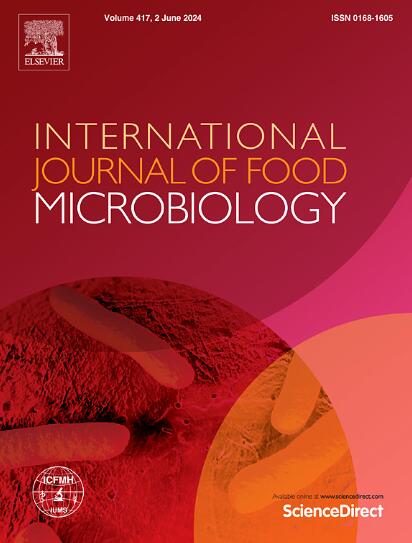Harnessing a deep-sea EAL-domain enzyme for quorum quenching and biofilm control in food pipelines
IF 5
1区 农林科学
Q1 FOOD SCIENCE & TECHNOLOGY
International journal of food microbiology
Pub Date : 2025-06-18
DOI:10.1016/j.ijfoodmicro.2025.111326
引用次数: 0
Abstract
This study explores the potential of quorum-quenching (QQ) enzymes from deep-sea bacteria to disrupt bacterial communication and biofilm formation. Among 21 psychrophilic marine isolates, Vibrio sp. strain SAT06 showed broad-spectrum QQ activity by degrading both short (C6-HSL) and long-chain (3-O-C12-HSL) acyl homoserine lactones. The QQ enzyme, identified as an EAL-domain-containing protein, exhibited high activity under refrigerated conditions (0–15 °C) and alkaline pH, further enhanced by Mg2+ and Ca2+ ions. Enzyme kinetics confirmed its hydrolytic activity against C6-HSL and 3-O-C12-HSL, validated by HPLC and acidification assays. SAT06 enzyme significantly reduced biofilm thickness (40–60 %) in Listeria monocytogenes and Pseudomonas fluorescens. It downregulated the agrA gene, a key regulator of biofilm formation in Gram-positive bacteria, and modified antibiotic resistance, restoring susceptibility in resistant pathogens. Mechanistically, the enzyme acts via lactone ring hydrolysis and modulates intracellular cyclic-di-GMP levels, as demonstrated by qualitative Congo red assays, thereby inhibiting quorum sensing-regulated biofilm formation and motility. The cold-active and stable nature of SAT06 under food processing conditions underscores its potential as an effective biofilm control agent. Future work may focus on enhancing enzyme durability through nanocoating for industrial deployment. This study also establishes a proof-of-concept for the SAT06 enzyme as a functional anti-biofilm surface coating within a model food-grade pipeline system.
利用深海eal结构域酶进行食品管道中的群体猝灭和生物膜控制
本研究探讨了深海细菌群体猝灭(QQ)酶在破坏细菌通讯和生物膜形成方面的潜力。在21株海洋嗜冷菌株中,SAT06对短链(C6-HSL)和长链(3-O-C12-HSL)酰基同丝氨酸内酯均表现出广谱的QQ活性。QQ酶是一种含有eal结构域的蛋白,在冷藏条件(0-15°C)和碱性条件下表现出较高的活性,Mg2+和Ca2+离子进一步增强了QQ酶的活性。酶动力学证实了其对C6-HSL和3-O-C12-HSL的水解活性,并通过HPLC和酸化实验验证。SAT06酶能显著降低单核增生李斯特菌和荧光假单胞菌的生物膜厚度(40 - 60%)。它下调了革兰氏阳性菌生物膜形成的关键调节因子agrA基因,并改变了抗生素耐药性,恢复了耐药病原体的敏感性。从机制上讲,该酶通过内酯环水解起作用,并调节细胞内循环二gmp水平,从而抑制群体感应调节的生物膜形成和运动,正如定性刚果红测定所证明的那样。在食品加工条件下,SAT06的冷活性和稳定性突出了它作为一种有效的生物膜控制剂的潜力。未来的工作重点可能是通过纳米涂层提高酶的耐久性,并用于工业部署。本研究还建立了SAT06酶在食品级管道系统模型中作为功能性抗生物膜表面涂层的概念验证。
本文章由计算机程序翻译,如有差异,请以英文原文为准。
求助全文
约1分钟内获得全文
求助全文
来源期刊
CiteScore
10.40
自引率
5.60%
发文量
322
审稿时长
65 days
期刊介绍:
The International Journal of Food Microbiology publishes papers dealing with all aspects of food microbiology. Articles must present information that is novel, has high impact and interest, and is of high scientific quality. They should provide scientific or technological advancement in the specific field of interest of the journal and enhance its strong international reputation. Preliminary or confirmatory results as well as contributions not strictly related to food microbiology will not be considered for publication.

 求助内容:
求助内容: 应助结果提醒方式:
应助结果提醒方式:


